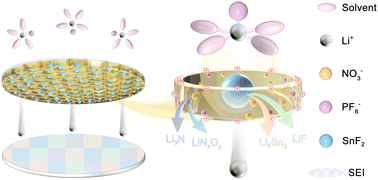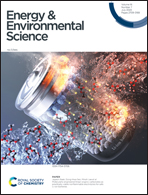A separator rich in SnF2 and NO3− directs an ultra-stable interface toward high performance Li metal batteries†
Abstract
Li metal batteries (LMBs) possess impressive application perspectives in energy storage, but are largely constrained by unsustainable lifespan and uncontrolled dendrite growth triggered by inhomogeneous and unstable solid electrolyte interphase (SEI). In this work, we conceived a SnF2 and NO3−-rich separator (PCS) by coating PP with a SnF2-encapsulated and NO3−-rich covalent organic framework (EB-COF:NO3@SnF2). It is demonstrated that the SnF2 and NO3− enrichment in PCS positively engages in the development of stable SEI by generating beneficial species including Li5Sn2 alloy, LiF, LiNxOy and Li3N, which endow the SEI with faster Li+ conductivity as well as reinforced stability, finally achieving high performance LMBs. With the application of PCS, Li symmetric cells endure a high current density and Li deposition capacity of 15 mA cm−2 and 30 mA h cm−2, respectively, while the performance of Li//NCM811 full cells is comprehensively improved, even sustaining stable cycling under conditions such as high temperatures (60 °C), high voltage (4.5 V), low N/P ratio (1.3) and lean electrolyte content, which proves the practicality of PCS for LMBs.



 Please wait while we load your content...
Please wait while we load your content...